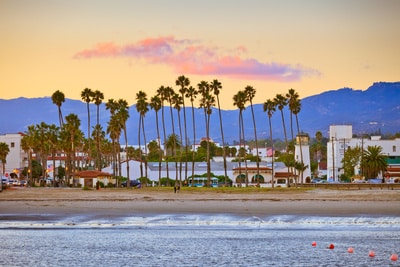
What city has the best weather in the United States? People have wondered about this since our nation’s founding. Gloomy and stormy weather is annoying, and it can even be expensive and dangerous! Especially if you’re a homeowner. Thus, calm and sunny weather is often at the top of people’s minds when considering a new place to live.
To help answer this question, we’ve compiled a list of the twenty US cities with the best weather. For the purposes of our list, we consider good weather to be any day that doesn’t have a high temperature above 90°F, a low temperature below 32°F, or cloudy skies. To rank cities, we added the number of days each city has bad weather using yearly average data from NOAA’s National Centers for Environmental Information (NCEI), with one “point” awarded per bad weather condition. The cities with the least number of bad weather points per year on average are atop our list.
Note that our rankings here are not suited to any particular person’s tastes in weather. Most people enjoy sunny, mild days, but some might find extreme heat a lot more annoying than extreme cold, or vice versa. Thus, we’ve also included the breakdown of how many “bad” weather days each city has so you can decide for yourself how various towns might compare.
For this list, we’ve only ranked cities and towns with a population greater than 25,000 and the cities that have a long-term weather observation site with reliable data. This criteria gives us a good mix of the best warm places to live in the US in major cities and smaller but still substantial towns that might offer more affordability in today’s hot housing market.
The 20 Cities With the Best Weather in the United States to Live In
With all that in mind, here are the 20 cities with the best weather in the US, on average.
1. Santa Barbara, California
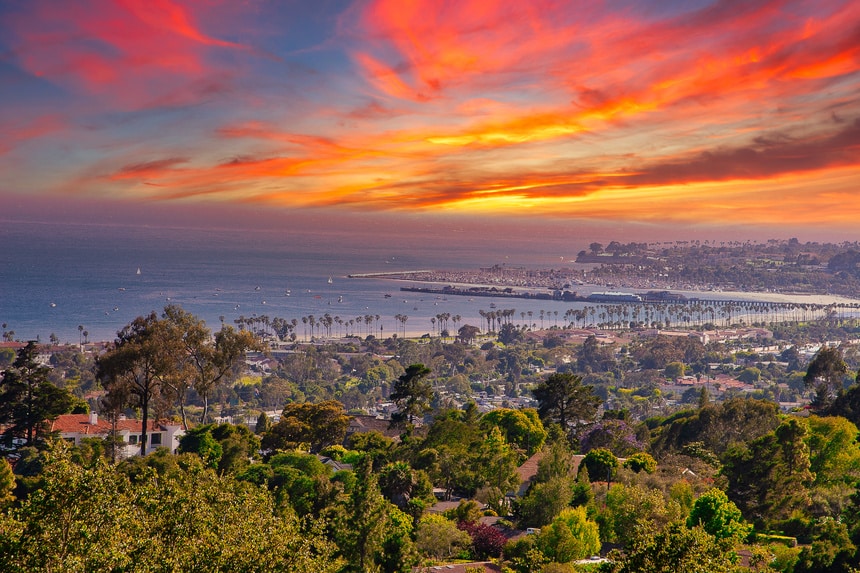
- Population: 87,533
- Average Annual Temperature: 59.7°F
- Number of 90°F or Higher Days Per Year: 3
- Number of 32°F or Lower Days Per Year: 6
- Cloudy Days Per Year: 80
- Clear and Partly Cloudy Days Per Year: 285
- Rainy Days Per Year: 36
- Zillow Home Value Index: $1,651,327
- Zillow Median Rent: $5,500
Santa Barbara, California, is home to the best weather in the United States, with just 80 cloudy days each year, 3 days above 90°F, and a mere 6 days with a morning low temperature at or below freezing. The weather in Santa Barbara is consistently pleasant because of its location in Southern California, south of the primary wintertime storm track that brings famously rainy weather to other parts of the state. In the summer, high pressure extending from the North Pacific to the Southwestern United States provides months of sunshine while the cool Pacific Ocean helps keep temperatures mild, making it one of the best warm places to live in the US.
Santa Barbara is one of the sunniest cities on our list, with just 80 days each year recording cloudy skies and 285 days under clear or partly cloudy skies. Just 36 days per year bring rain, on average. This is all due to that big ridge of high pressure discussed above and is one of the reasons Santa Barbara has earned the nickname “Riviera of the Americas,” as it shares the famously nice weather of southern France and Italy.
While extreme or dangerous weather is rare, wildfires in the nearby Santa Ynez mountains can occasionally prompt evacuations in neighborhoods on the northern side of town, away from the water. There is also the threat of earthquakes and tsunamis to be aware of since Santa Barbara is near the San Andreas fault. Thankfully, these geological hazards are rare on human timescales.
Given the nearly-perfect weather, beautiful scenic coastline, and friendly small-town charm, Santa Barbara is one of the most sought-after towns in America for buyers and renters. As a result, expect to pay up if you’d like to settle down here. The median home in Santa Barbara sells for over 1.5 million dollars as of August 2023, with rental prices averaging $5,500 per month.
2. San Diego, California
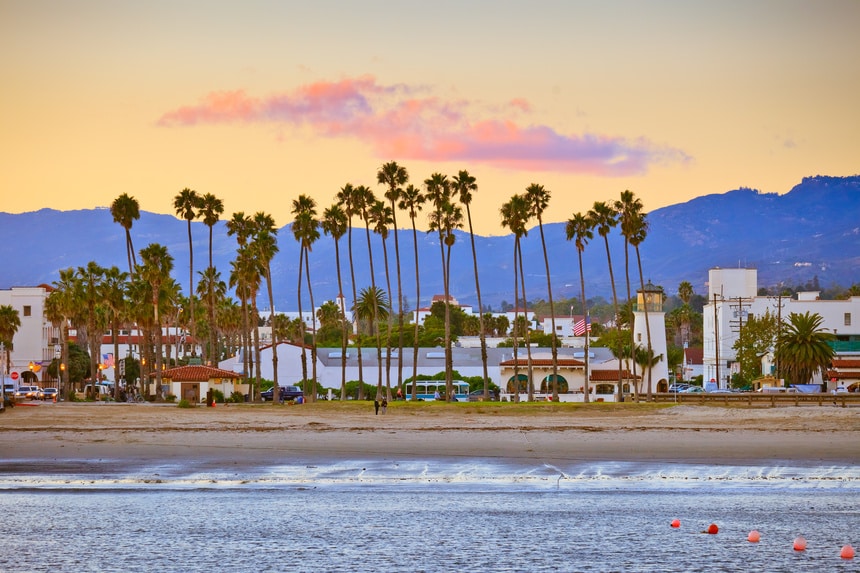
- Population: 1,381,162
- Average Annual Temperature: 64.3°F
- Number of 90°F or Higher Days Per Year: 3
- Number of 32°F or Lower Days Per Year: 0
- Cloudy Days Per Year: 102
- Clear and Partly Cloudy Days Per Year: 263
- Rainy Days Per Year: 41
- Zillow Home Value Index: $939,059
- Zillow Median Rent: $3,395
San Diego is one of America’s most famously pleasant cities in terms of weather. It makes a strong case for itself, primarily because of its lack of extreme temperatures. Despite its location right along the US-Mexico border, not far from some of America’s hottest terrain, San Diego only records 3 days each year with a temperature above 90°F! This is because the nearby Pacific Ocean stays cool through the summer, acting as a natural source of air conditioning for the city. San Diego is well-protected from severe or extreme weather, though strong Santa Ana winds can sometimes fuel dangerous wildfires, especially in the hillier suburbs.
Much like Santa Barbara, San Diego enjoys an incredible amount of sunshine each year as it sits under strong, high pressure that extends from the Desert Southwest into the northeastern Pacific Ocean. On average, only 102 days yearly have cloudy or mostly cloudy skies, while 263 remain clear or partly cloudy.
San Diego is home to a substantial United States Navy base and several large universities, including San Diego State University and the University of California San Diego campus. In recent years, San Diego has emerged as a hub of biotechnology research and development, with several biotech companies moving to and starting in the city. Tourism also plays a significant role in the city’s economy, given the nice weather and several prominent attractions such as SeaWorld and Legoland. San Diego also has California’s third-busiest port and one of the busiest border crossings in the world at San Ysidro.
San Diego is a popular place to live and thus has high home and rental prices, with average home prices just shy of one million dollars as of August 2023.
3. San Francisco, California
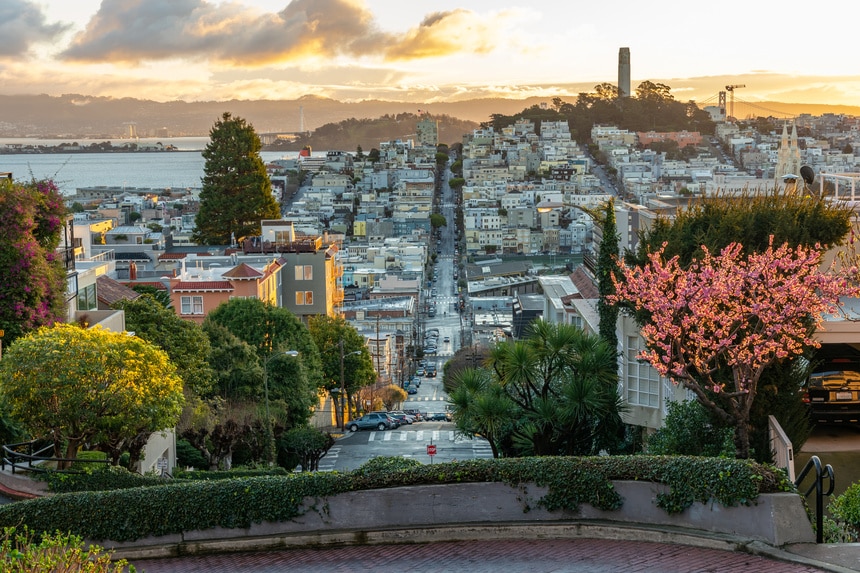
- Population: 808,437
- Average Annual Temperature: 58.2°F
- Number of 90°F or Higher Days Per Year: 2
- Number of 32°F or Lower Days Per Year: 0
- Cloudy Days Per Year: 105
- Clear and Partly Cloudy Days Per Year: 260
- Rainy Days Per Year: 67
- Zillow Home Value Index: $1,269,632
- Zillow Median Rent: $3,539
Home to Silicon Valley, the core of the United States technology industry, San Francisco pairs fairly great weather with some of the most lucrative jobs in the world. As a result, don’t expect housing here to come cheap. The average home sold in San Francisco in August 2023 costs over 1.25 million dollars!
For those who can afford San Francisco, the city can promise good weather and mild temperatures thanks to its proximity to the cool Pacific Ocean. In the summer, fog can sometimes envelop the city for days, but clear skies can usually be found with a short drive into the surrounding hills. San Francisco is a bit cloudier than its neighbors to the south, but not by a significant margin, with 105 cloudy days each year and 260 days of clear or mostly clear skies. Keep in mind that these statistics come from the airport, which is located a little south of downtown and doesn’t experience fog quite as often during the summer.
4. Kahului, Hawaii
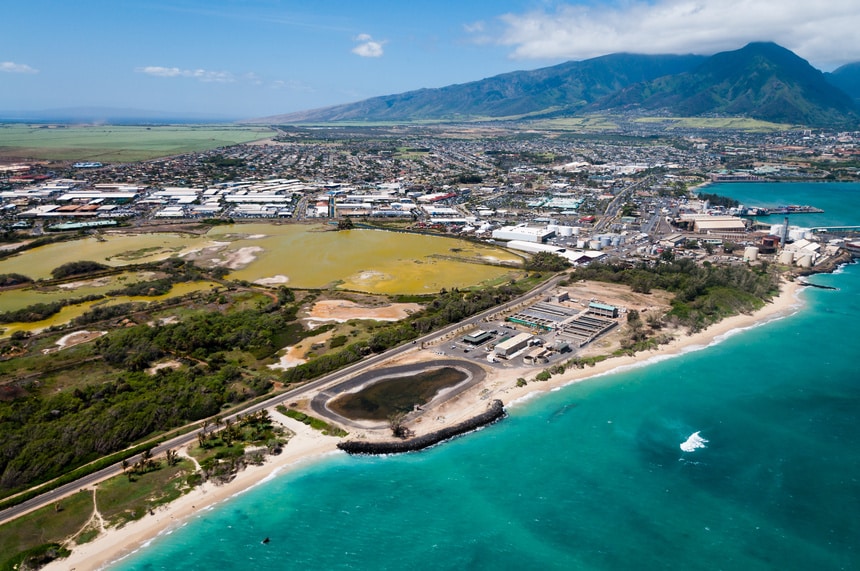
- Population: 29,993
- Average Annual Temperature: 76.3°F
- Number of 90°F or Higher Days Per Year: 28
- Number of 32°F or Lower Days Per Year: 0
- Cloudy Days Per Year: 90
- Clear and Partly Cloudy Days Per Year: 275
- Rainy Days Per Year: 88
- Zillow Home Value Index: $942,223
- Zillow Median Rent: $2,300
Nestled on Maui’s northern shoreline, Kahului is ideally positioned to remain warm and relatively sunny year-round, though some showers and thunderstorms occur in winter. Kahului is a bit warmer than nearby Honolulu because it can sometimes experience warm downslope winds off Haleakala, Maui’s highest peak. When air descends, it warms up and dries out, and this phenomenon helps bring Kahului 28 days above 90°F each year.
This downsloping also helps keep Kahului sunnier than some other parts of Hawaii. The city only records 90 cloudy days in an average year, while 275 days remain clear or mostly clear. If it’s cloudy in Kahului, it’s probably also raining, with 88 days of rain recorded each year on average, but thankfully, that doesn’t happen very often, especially not in the summer.
Kahului’s economy is largely oriented around tourism, given the massive interest in Hawaii’s nice weather and abundant natural beauty. World-class hiking, biking, and surfing are available within a short drive. Kahului is slightly more affordable than other Hawaiian cities but is still more expensive than most towns on the mainland. Expect to pay nearly a million dollars to buy a house in Kahului, while renting will cost you $2,300 each month.
5. Honolulu, Hawaii
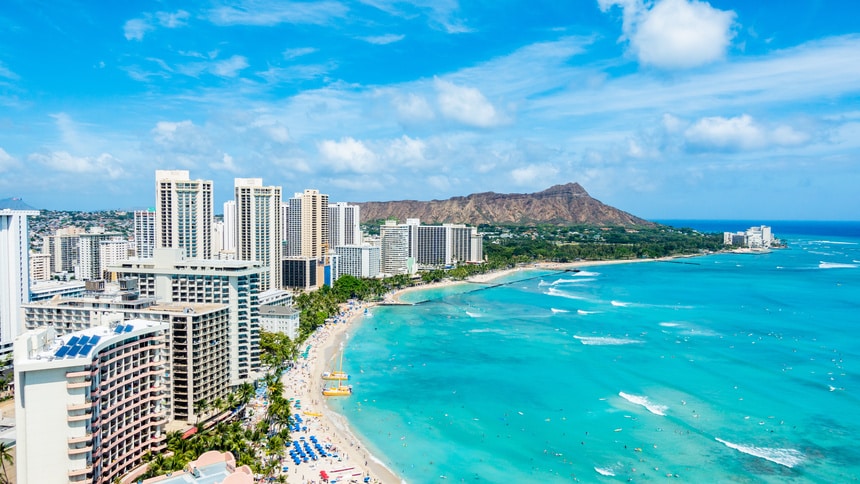
- Population: 343,421
- Average Annual Temperature: 78.1°F
- Number of 90°F or Higher Days Per Year: 25
- Number of 32°F or Lower Days Per Year: 0
- Cloudy Days Per Year: 94
- Clear and Partly Cloudy Days Per Year: 271
- Rainy Days Per Year: 92
- Zillow Home Value Index: $800,614
- Zillow Median Rent: $2,675
Like Kahului, Honolulu is an excellent destination if you like warm and sunny weather year-round. It’s ever so slightly warmer and cloudier than its neighbor to the west, thanks to Oahu’s more modest topography and Honolulu’s position on the eastern (windward) side of the island. That said, Honolulu still boasts 271 clear or mostly sunny days, with just 94 that have more substantial cloud cover.
Temperatures in Honolulu rarely stray much from the very comfortable 78.1°F average. However, it can get a bit warm in the summer when 25 days with a high temperature above 90°F are recorded on average. Honolulu is generally a pretty sunny place, especially in the summer. In the winter, however, there are just a few cloudy days when it might rain. While Honolulu’s weather poses little threat to residents, Hawaii is prone to other hazards like earthquakes and tsunamis.
Honolulu is a major tourist destination since it is the primary jumping-off point for visitors looking to experience Hawaii’s vibrant culture and jaw-dropping natural landscape. Honolulu is also home to the United States Pacific Fleet, the largest naval command in the world, in nearby Pearl Harbor.
Honolulu and its surroundings offer plenty of activities, including surfing, hiking, and golfing. In part because of its desirable climate, Honolulu is an expensive place to buy or rent a house, with average rental prices over $2,500 and average home prices reaching $800,000 as of August 2023.
6. Los Angeles, California

- Population: 3,822,238
- Average Annual Temperature: 63.7°F
- Number of 90°F or Higher Days Per Year: 21
- Number of 32°F or Lower Days Per Year: 0
- Cloudy Days Per Year: 103
- Clear and Partly Cloudy Days Per Year: 262
- Rainy Days Per Year: 35
- Zillow Home Value Index: $907,874
- Zillow Median Rent: $2,958
Just up the coast from San Diego is the much larger city of Los Angeles, with similarly warm weather. The Urban Heat Island effect, where vast expanses of concrete, asphalt, and hot exhaust from vehicles and buildings create a small bubble of warmer air over cities, is especially pronounced in Los Angeles, given its infamous sprawl. Thus, Los Angeles can record an average of 21 days above 90°F each year.
Los Angeles occasionally faces the threat of wildfires due to strong Santa Ana winds and the city’s generally dry climate. Otherwise, the city’s risk from extreme weather is relatively low. However, the high-pressure systems responsible for its abundant sunshine can trap pollutants near the ground and cause poor air quality, also known as smog. Los Angeles is also famously prone to earthquakes, given its proximity to the San Andreas fault.
Los Angeles is home to a wide variety of businesses, from the entertainment industry in Hollywood to the Port of Los Angeles, which is the busiest in the United States. Los Angeles is also the largest manufacturing center in the United States, and it’s home to several major universities, such as the University of Southern California. Los Angeles residents have easy access to an incredible variety of jobs, cultural landmarks, performing arts, music, and much more.
7. Key West, Florida
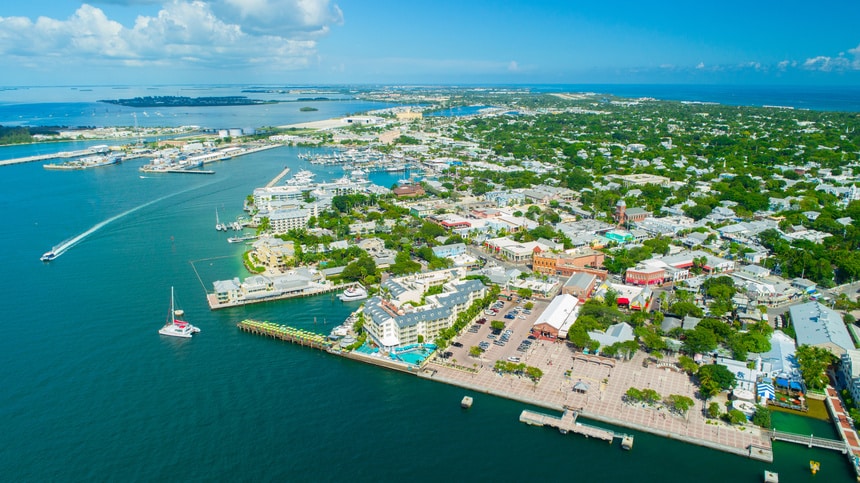
- Population: 25,597
- Average Annual Temperature: 78.5°F
- Number of 90°F or Higher Days Per Year: 50
- Number of 32°F or Lower Days Per Year: 0
- Cloudy Days Per Year: 107
- Clear and Partly Cloudy Days Per Year: 258
- Rainy Days Per Year: 107
- Zillow Home Value Index: $1,076,312
- Zillow Median Rent: $5,800
Key West is our first entry from the East Coast with a very warm climate year-round thanks to the warm waters of the Gulf of Mexico, which surround the tiny island of Key West on all sides. The warm Gulf water keeps temperatures mild through the winter, with subfreezing days being exceedingly rare (a few have been recorded, but an average year brings zero), and it helps keep the heat at bay in the summer, although the humidity can be stifling. High-pressure systems often camp above Key West both in the summer and winter, resulting in plenty of sunshine. On average, 258 days each year are clear or mostly clear in Key West, with less than a third of the year spent under cloudy skies. Due to the consistently warm winters, Key West is the second warmest city in the US, based on average annual temperature.
While Key West offers an appealing climate in terms of temperatures and sunshine, it is at significant risk from hurricane strikes. Several powerful storms have raked the island and caused substantial damage, most recently in 2017 when Hurricane Irma made landfall as a Category Three storm. Key West is one of only a few places to have been hit by a Category Five hurricane at full intensity back on Labor Day in 1935. If you choose to move to Key West, be sure you’re aware of the risk posed by hurricanes!
Key West’s small-town feel and generally pleasant weather attract tourists looking to escape harsh winters farther north. As a result, the city’s economy is primarily tourism-based, though a Naval Air Station also provides some residents with jobs. Due to its small size and high demand, Key West is a pricey place to live, with new homes averaging around one million dollars and average rentals costing over $5,000 per month.
8. Miami, Florida
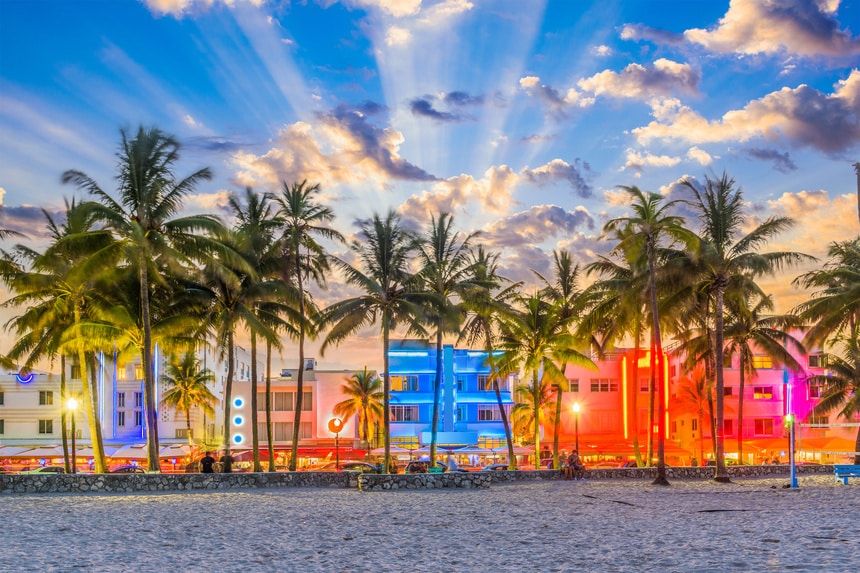
- Population: 449,514
- Average Annual Temperature: 77.7°F
- Number of 90°F or Higher Days Per Year: 70
- Number of 32°F or Lower Days Per Year: 0
- Cloudy Days Per Year: 115
- Clear and Partly Cloudy Days Per Year: 250
- Rainy Days Per Year: 134
- Zillow Home Value Index: $549,443
- Zillow Median Rent: $3,400
The cultural center of Florida, Miami, takes the number eight spot on our list with abundant sunshine and warm winters despite hot and humid summers. If you really can’t stand the cold and don’t mind a little heat, Miami could be the place for you! An average year in Miami brings just 115 cloudy days, with the rest of the year, 250 days, being partly or mostly sunny. Much like Key West, though, Miami is at risk for damaging hurricane strikes, which is worth keeping in mind if considering a move to the area.
Miami’s climate may be similar to Key West’s, but it has a wider array of industries and activities than its island neighbors. Miami is a major finance and banking hub. Thanks to its vibrant Latin American immigrant communities, it’s a center for culture and arts. The city is also home to the University of Miami, a major university. Miami is a bit more affordable than the islands to its south, but it still isn’t cheap with a rental market that’s especially hot. Median rental properties in Miami go for $3,400 as of August 2023, while the average house sells for $549,443.
9. Sacramento, California
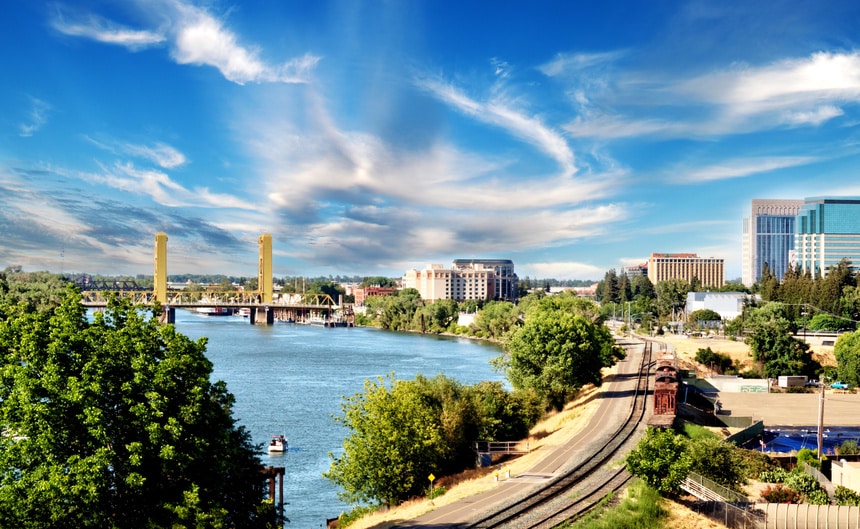
- Population: 528,001
- Average Annual Temperature: 61.8°F
- Number of 90°F or Higher Days Per Year: 74
- Number of 32°F or Lower Days Per Year: 18
- Cloudy Days Per Year: 100
- Clear and Partly Cloudy Days Per Year: 265
- Rainy Days Per Year: 57
- Zillow Home Value Index: $465,589
- Zillow Median Rent: $2,050
Sacramento, the capital of California, enjoys reliably warm and sunny summers and cool winters thanks to its location in the state’s Central Valley. Flanked by the coastal mountain ranges to the west and the Sierra Nevada to the east, Sacramento is well-protected from strong storms that tend to focus their energy on steep mountain slopes. The drying effect of having these mountains nearby also makes Sacramento a very sunny place, with just 100 days of overcast recorded in an average year. Sacramento is a bit farther inland than some other cities on our list, so it gets warmer in the summer and cooler in the winter. That said, it is still a comfortable place to live if you dislike extreme temperatures, especially extreme cold.
Sacramento is well protected from most extreme weather, though the Sacramento River can occasionally flood during periods of intense springtime snowmelt. There is also some risk of earthquakes, like there is in most of California.
Despite its very nice temperate climate, Sacramento is one of the more affordable towns on our list, especially for buyers, with median home prices not quite cracking $500,000. Sacramento is famous for being the “City of Trees.” It’s one of the world’s greenest cities, next to Vancouver and Singapore. Sacramento has many thriving industries, but farming is most prominent given the city’s location in the highly fertile Central Valley. Trade is also a big part of Sacramento’s economy because it has a deepwater port connected to San Francisco Bay.
10. Fort Myers, Florida
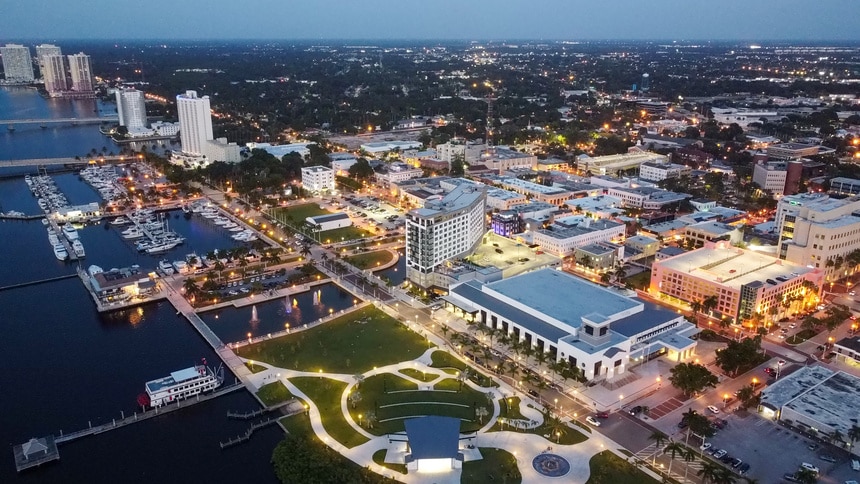
- Population: 95,949
- Average Annual Temperature: 75.5°F
- Number of 90°F or Higher Days Per Year: 100
- Number of 32°F or Lower Days Per Year: 1
- Cloudy Days Per Year: 99
- Clear and Partly Cloudy Days Per Year: 266
- Rainy Days Per Year: 113
- Zillow Home Value Index: $370,857
- Zillow Median Rent: $2,500
Despite hot and humid summers, located on Florida’s southwestern coast, just across the peninsula from Miami, Fort Myers takes our number ten spot. The city averages 100 days over 90°F each year, but only one that dips below freezing. There’s plenty of sunshine, too: only 99 days are mostly or entirely cloudy! Despite the generally nice weather, Fort Myers is vulnerable to hurricanes, as residents were painfully reminded in September 2022 when Hurricane Ian caused considerable damage to the city and its surroundings.
Fort Myers is a popular retirement destination thanks to its sunny weather and relatively low cost of living. Fort Myers is among the most affordable cities on our list, with homes selling for $370,857 on average as of August 2023 and rentals going for $2,500 per month on average. Tourism also significantly contributes to Fort Myers’ economy, and many of its residents work in the service sector.
11. West Palm Beach, Florida
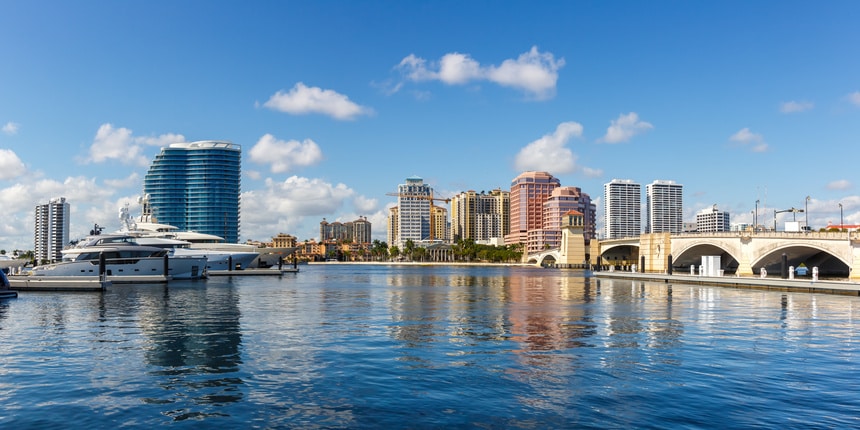
- Population: 120,932
- Average Annual Temperature: 76.1°F
- Number of 90°F or Higher Days Per Year: 75
- Number of 32°F or Lower Days Per Year: 0
- Cloudy Days Per Year: 131
- Clear and Partly Cloudy Days Per Year: 234
- Rainy Days Per Year: 134
- Zillow Home Value Index: $407,606
- Zillow Median Rent: $2,600
Just north of Miami, West Palm Beach enjoys a similarly warm and sunny climate, with the risk of hurricanes to be mindful of when considering a move. West Palm Beach is a bit more affordable than its better-known neighbor to the south but is still more expensive than Florida’s western coast. West Palm Beach is mainly populated by retirees and those who work in the tourism industry. West Palm Beach’s abundant sunshine, with 234 clear or mostly clear days each year, is a big reason so many people choose to visit and retire to the city.
12. Stockton, California
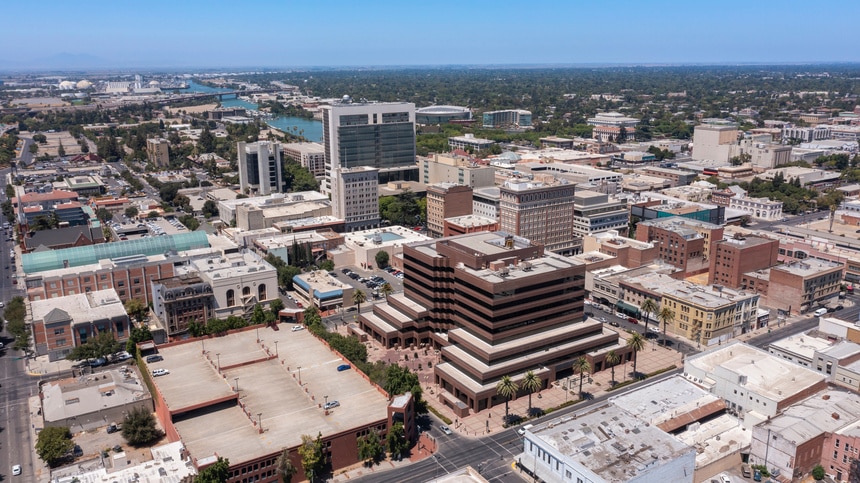
- Population: 321,819
- Average Annual Temperature: 62.5°F
- Number of 90°F or Higher Days Per Year: 84
- Number of 32°F or Lower Days Per Year: 22
- Cloudy Days Per Year: 104
- Clear and Partly Cloudy Days Per Year: 261
- Rainy Days Per Year: 55
- Zillow Home Value Index: $426,148
- Zillow Median Rent: $1,890
Situated between San Francisco and Sacramento, Stockton, California, is another sunny and mild town in the state’s Central Valley. Sitting between two formidable mountain ranges, Stockton enjoys abundant sunshine 261 days of the year, with most of the cloudy days packed into a few rainy months during the winter. Temperatures are more prone to getting uncomfortably hot than uncomfortably cold here, with 84 days above 90°F but just 22 days below 32°F.
Stockton is much more affordable than its neighbor to the west, San Francisco, but is among the more expensive towns in the Central Valley, with average home prices sitting at $426,148 and average rentals going for $1,890 per month as of August 2023. Stockton was once a major hub during the California Gold Rush, but its economy has shifted toward agriculture, arts, and trade.
13. Tampa, Florida
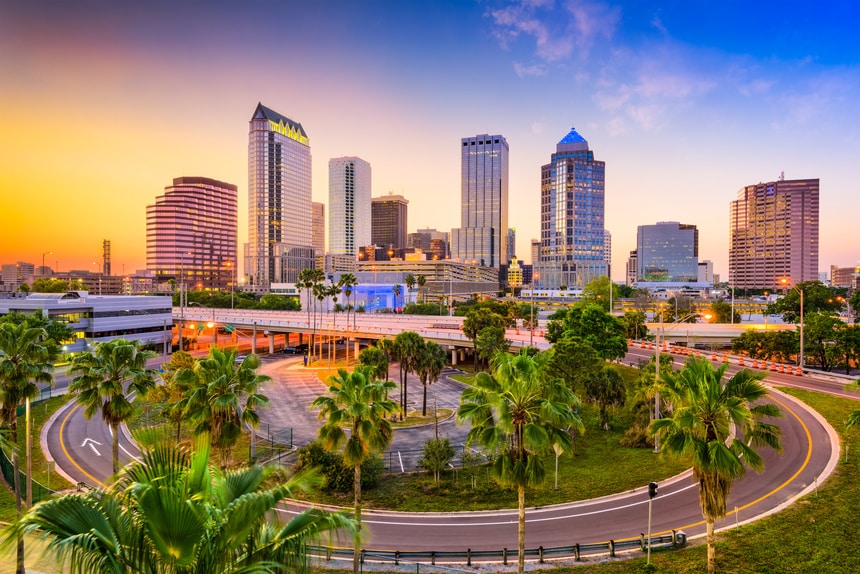
- Population: 398,173
- Average Annual Temperature: 74.0°F
- Number of 90°F or Higher Days Per Year: 88
- Number of 32°F or Lower Days Per Year: 2
- Cloudy Days Per Year: 121
- Clear and Partly Cloudy Days Per Year: 244
- Rainy Days Per Year: 107
- Zillow Home Value Index: $390,746
- Zillow Median Rent: $2,340
Much like Fort Myers just to the south, Tampa enjoys plenty of warm weather and sunshine, given its location under subtropical high-pressure systems for most of the year. On average, Tampa records 244 sunny or mostly sunny days each year, with just 121 days of overcast and 107 days of rain. Tampa can get uncomfortably hot, with an average of 88 days above 90°F each year, but it rarely gets cold, with just 2 days at or below freezing in an average year.
Tampa is a major hub for tourism, health care, insurance, and maritime trade, driven by the city’s port, which is the largest in Florida. Thanks to an abundance of new houses that the relatively lax zoning laws have propelled, Tampa has comparatively affordable housing, with homes selling for an average of $390,746 and rentals going for an average of $2,340 per month as of August 2023.
14. Bakersfield, California
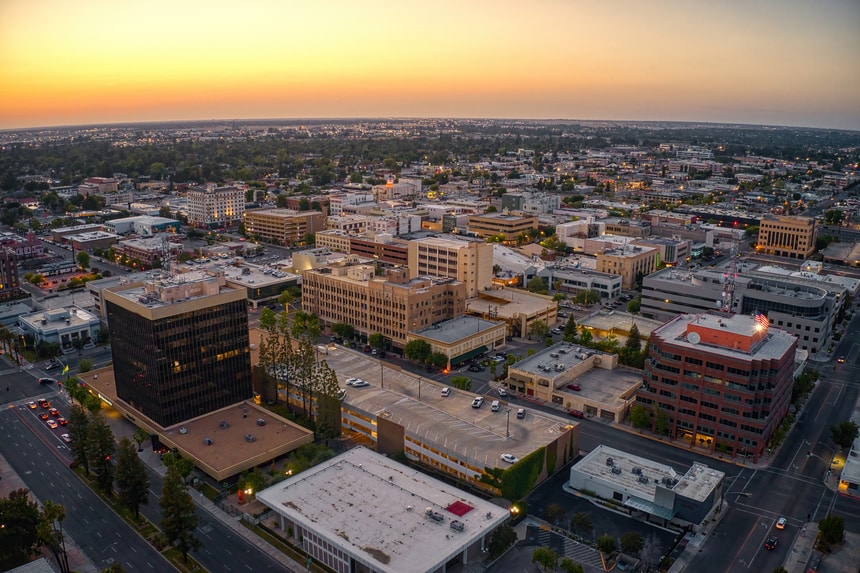
- Population: 410,647
- Average Annual Temperature: 66.0°F
- Number of 90°F or Higher Days Per Year: 110
- Number of 32°F or Lower Days Per Year: 13
- Cloudy Days Per Year: 93
- Clear and Partly Cloudy Days Per Year: 272
- Rainy Days Per Year: 37
- Zillow Home Value Index: $378,288
- Zillow Median Rent: $1,750
Another entry from the Central Valley, Bakersfield enjoys the same advantages as many other California cities on our list. Strong subtropical high-pressure systems keep skies clear for much of the year, with 272 days of sunshine recorded on average in Bakersfield. Temperatures are moderate, though Bakersfield can get hotter than most other towns we’ve discussed, given that it’s located at the southern edge of the Central Valley. An average year brings 110 days, nearly four months, of temperatures above 90°F but only 13 days below 32°F.
Like the other Central Valley towns, Bakersfield is relatively affordable, and its economy is largely driven by agriculture.
15. Fresno, California
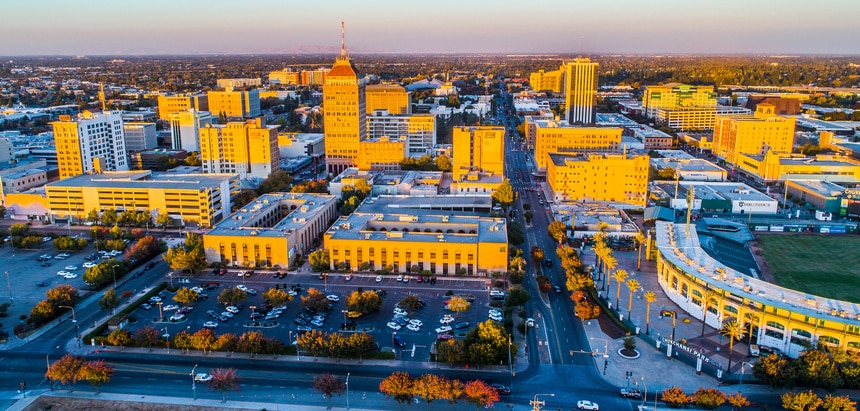
- Population: 545,567
- Average Annual Temperature: 65.3°F
- Number of 90°F or Higher Days Per Year: 108
- Number of 32°F or Lower Days Per Year: 19
- Cloudy Days Per Year: 98
- Clear and Partly Cloudy Days Per Year: 267
- Rainy Days Per Year: 45
- Zillow Home Value Index: $365,712
- Zillow Median Rent: $1,500
Located in California’s San Joaquin Valley, Fresno is one of the most affordable US cities with the best weather on our list, with new home prices sitting near $350,000 as of August 2023 and the median rental property going for just $1,500 per month. It is a bit warmer than most other cities we’ve discussed, with 108 days above 90°F on average each year. Fresno’s location farther inland than most other cities listed above lets it get warmer in the summer and cooler in the winter, though its climate is mild compared to many other parts of the country.
Being in the Central Valley also comes with a significant advantage in terms of sunshine, as the coastal ranges and Sierra Nevada help protect Fresno from cloudiness by taking a considerable amount of moisture out of the air before it can reach the city limits. Only 98 days yearly are cloudy in Fresno, with the other 267 being clear or mostly clear.
Farming is Fresno’s primary economic activity, given that it’s located amidst some of the world’s most fertile soil. Tourism is also a significant part of Fresno’s economy, as it’s the jumping-off point for visitors looking to explore the southern Sierra Nevada’s national parks, such as Yosemite, Kings Canyon, and Giant Sequoia.
16. Redding, California
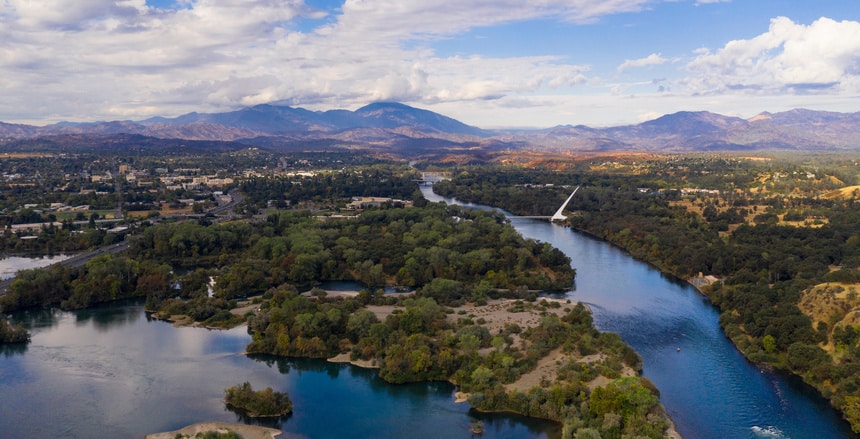
- Population: 92,906
- Average Annual Temperature: 63.1°F
- Number of 90°F or Higher Days Per Year: 105
- Number of 32°F or Lower Days Per Year: 29
- Cloudy Days Per Year: 116
- Clear and Partly Cloudy Days Per Year: 249
- Rainy Days Per Year: 79
- Zillow Home Value Index: $390,282
- Zillow Median Rent: $1,400
Located at the far northern end of California’s Central Valley, Redding enjoys a similar climate to Sacramento and Fresno farther south. It can be warm in the summer and cool in the winter, but there’s plenty of sunshine (249 clear or mostly clear days), and humidity generally remains low throughout the year. In the winter, strong storm systems can approach the city, but the mountains west, north, and east of the town absorb much of the heavy rain and snow. While Redding’s weather is generally pleasant, the city is at risk from wildfires. The Fawn Fire in 2021 prompted the evacuation of nearly 4,000 residents and destroyed 185 buildings in and around Redding.
Redding is a reasonably affordable place to live, with prices similar to Fresno. Tourism primarily drives its economy after its historic mining and forestry industries gradually faded during the late 20th century.
17. Albuquerque, New Mexico
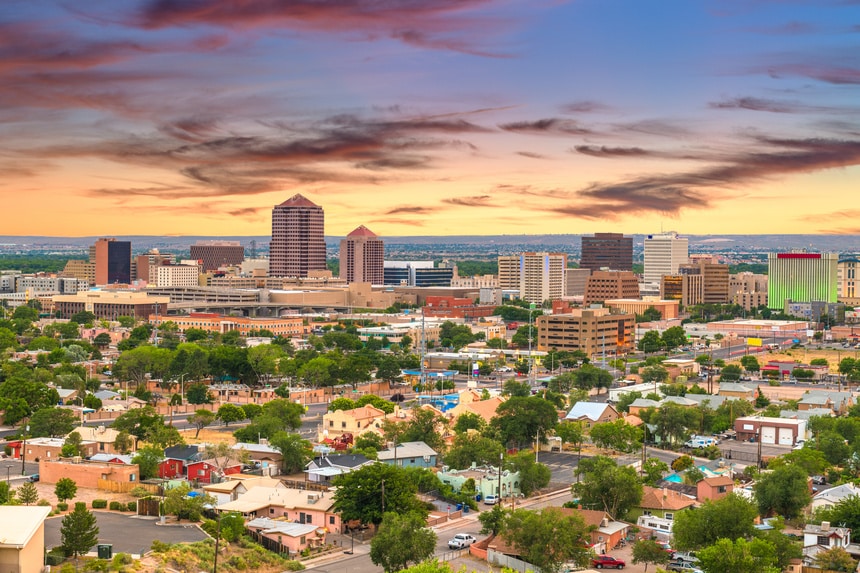
- Population: 561,008
- Average Annual Temperature: 58.3°F
- Number of 90°F or Higher Days Per Year: 64
- Number of 32°F or Lower Days Per Year: 109
- Cloudy Days Per Year: 87
- Clear and Partly Cloudy Days Per Year: 278
- Rainy Days Per Year: 59
- Zillow Home Value Index: $323,682
- Zillow Median Rent: $1,465
Albuquerque, New Mexico, is the only city from the Desert Southwest on our list, mainly because most of Arizona is outrageously hot during the summer. Albuquerque offers a good mix of moderate summers, cool but not cold winters, and abundant sunshine. Albuquerque’s primary severe weather hazard is occasional dust storms that arise when winds pick up, especially during the springtime. Other than that, though, the city is mostly safe from severe or extreme weather.
Albuquerque is a major hub for artists, foodies, and outdoor enthusiasts who use the city’s easy access to mountain ranges and vast expanses of rugged wilderness just outside the city limits. Albuquerque is also home to the Albuquerque International Balloon Fiesta, a significant gathering of hot air balloon enthusiasts, and the New Mexico State Fair.
18. Greensboro, North Carolina
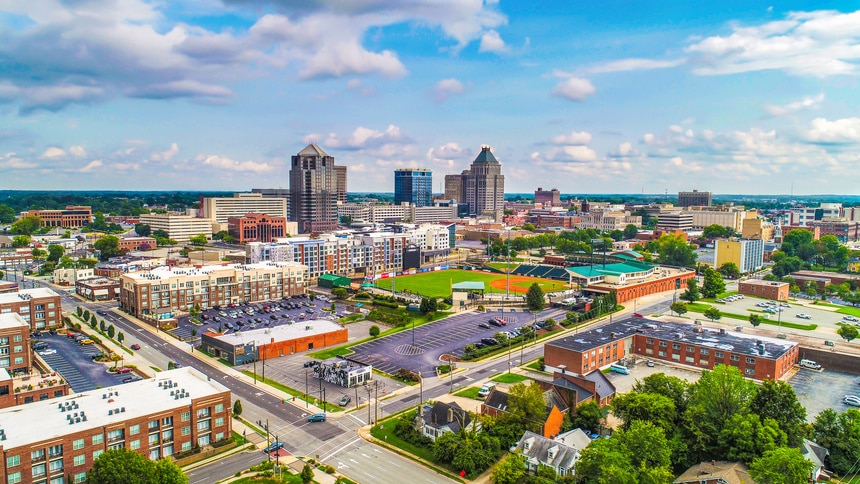
- Population: 301,115
- Average Annual Temperature: 59.5°F
- Number of 90°F or Higher Days Per Year: 34
- Number of 32°F or Lower Days Per Year: 80
- Cloudy Days Per Year: 150
- Clear and Partly Cloudy Days Per Year: 215
- Rainy Days Per Year: 116
- Zillow Home Value Index: $248,515
- Zillow Median Rent: $1,505
Located in north-central North Carolina, Greensboro is our first entry from the East Coast outside of Florida. The city’s location, a bit away from the coast and slightly closer to the Appalachian Mountains that dominate the western part of North Carolina, helps it stay a bit sunnier than most of the rest of the state. However, nearly half the year is still mostly or entirely cloudy.
What Greensboro lacks in sunshine relative to other cities on our list, it makes up for in mild temperatures. Just 34 days in an average year crack 90°F while 80 days dip below 32°F. Greensboro is at relatively low risk from severe or extreme weather, though tornadoes have been observed nearby, including one F4 storm that struck the downtown part of Greensboro head-on in 1936. Hurricanes sometimes drop heavy rain on the city but usually don’t strike with as much ferocity as other parts of North Carolina closer to the ocean.
Greensboro is part of North Carolina’s “research triangle” and is home to several technology and manufacturing businesses and the University of North Carolina at Greensboro. It is among the most affordable cities on our list, with an average home price of $248,515 and an average rental price of $1,505 as of August 2023.
19. Lubbock, Texas
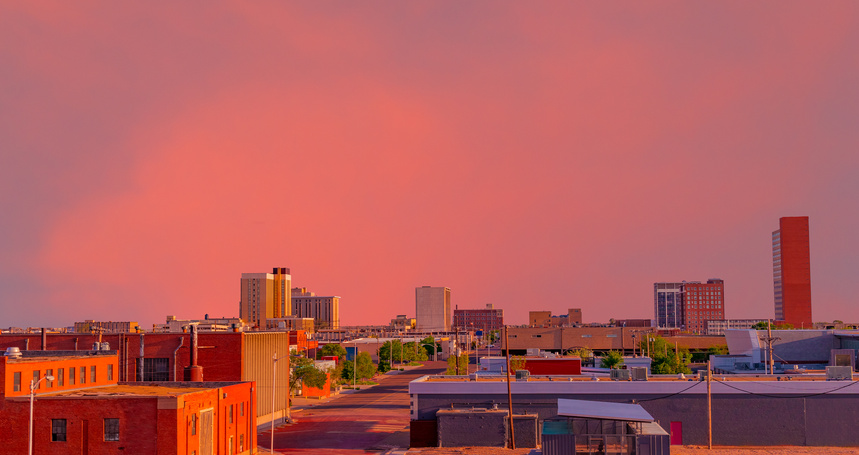
- Population: 263,930
- Average Annual Temperature: 61.6°F
- Number of 90°F or Higher Days Per Year: 85
- Number of 32°F or Lower Days Per Year: 90
- Cloudy Days Per Year: 103
- Clear and Partly Cloudy Days Per Year: 262
- Rainy Days Per Year: 63
- Zillow Home Value Index: $209,036
- Zillow Median Rent: $1,399
Lubbock, Texas, takes the title of most affordable city with the best weather in the United States, with 262 days of sunshine each year and an average home price of just $209,036 as of August 2023. However, in exchange for abundant sunshine and cheap living, you’ll have to deal with a bit more in the way of extreme temperatures than many other cities on our list.
An average year in Lubbock brings 85 days above 90°F while another 90 days dip below 32°F. Severe weather can pose a significant risk when the skies aren’t sunny in Lubbock. Large hail, powerful winds, and tornadoes have all been observed in and around Lubbock with some frequency during the springtime severe weather season. Dust storms are also a somewhat common occurrence, mainly during the spring.
Lubbock is home to Texas Tech University and many large energy companies. The nearby Permian Basin is one of America’s most productive oil and gas fields, and the bright sunshine and consistent wind of the Texas Panhandle make it an ideal site for renewable energy development.
20. Columbia, South Carolina
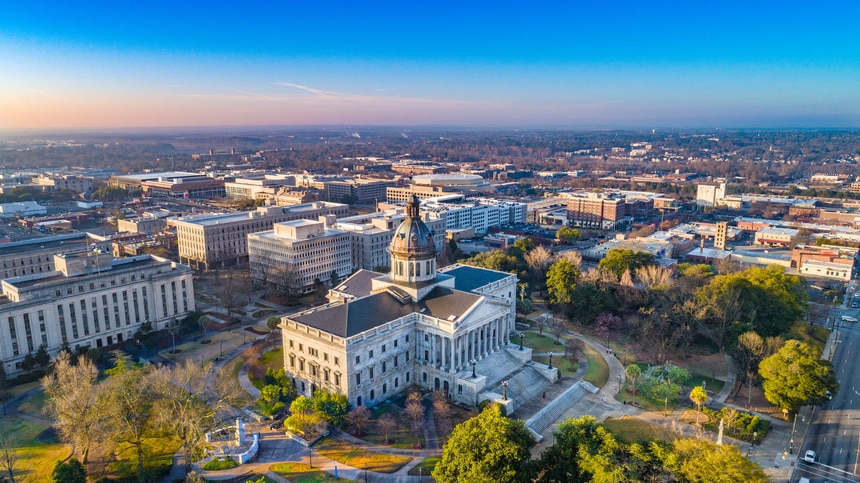
- Population: 139,698
- Average Annual Temperature: 66.8°F
- Number of 90°F or Higher Days Per Year: 79
- Number of 32°F or Lower Days Per Year: 54
- Cloudy Days Per Year: 147
- Clear and Partly Cloudy Days Per Year: 218
- Rainy Days Per Year: 109
- Zillow Home Value Index: $221,256
- Zillow Median Rent: $1,525
The last city on our list is Columbia, South Carolina. Like Greensboro, North Carolina, Columbia isn’t the sunniest city on our list, but it has cooler summers and milder winters than many surrounding locales. An average year in Columbia brings 79 days above 90°F and 54 days below 32°F but only 218 days of clear or mostly clear skies. Columbia is at a relatively low risk from extreme weather, but severe thunderstorms do happen in the spring and summer, and hurricanes can approach from time to time during late summer and early fall.
Columbia is the capital of South Carolina and is also home to the University of South Carolina, the state’s flagship public university. Columbia is also the site of a significant United States Army base, Fort Jackson, and McEntire Joint National Guard Base. Together, these institutions provide the majority of jobs in the Columbia area.
Final Thoughts
If you’re looking for moderate temperatures and sunny skies, the cities with the best weather in America are generally found in the states of Hawaii, California, and Florida. This list includes some well-known major cities like San Francisco, Los Angeles, and Miami, which offer immense economic and cultural opportunities but at the cost of extremely expensive housing. At the same time, some hidden gems like Albuquerque, Redding, and Fresno offer excellent climates with warm and sunny weather at a much lower housing price point. To see more cities with plenty of sunshine year-round, take a look at our list of the sunniest cities in the US.
Despite the generally pleasant weather in many of these cities, there are some severe weather risks to consider when looking to buy or rent a house. Many towns in California, for example, are prone to wildfires, while Florida has to deal with hurricanes occasionally. Choosing a new city to move to is a complex decision, but hopefully, this article can help you choose a warm place to live with sunny weather in the summer and mild winters if that’s one of your priorities.
Data for this article comes from a variety of sources. Cloud cover, extreme temperature, and rainfall data come from NOAA’s National Centers for Environmental Information (NCEI) and their Comparative Climate Data Library. Annual average temperatures come from Extreme Weather Watch, which contains official up-to-date temperature records using the most recent 1991-2020 climate period to account for some of the effects of climate change. The home and rental price information is obtained through Zillow’s online tools.




